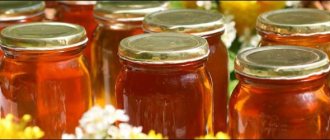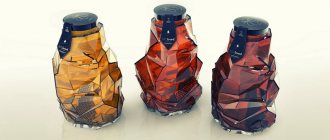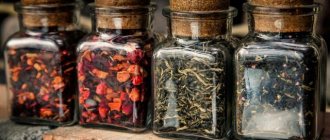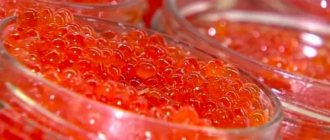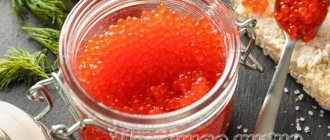Honey is one of the most useful products given by nature. It will be more beneficial if consumed in its raw form, i.e. in honeycombs. This product contains pollen, propolis, wax, and bruises. Its composition is rich in vitamins, amino acids, carotene, succinic acid, sucrose and other substances necessary for our body. Honey should be stored in honeycombs according to the rules, so it will not lose its freshness and beneficial properties.
Storage conditions for comb honey
Honey has good preservative properties and can be stored for a long time. But despite this, there are a number of conditions that must be adhered to.
The rules for storing honey in honeycombs are practically no different from the storage conditions for a product packaged in glass containers (an article on this topic is here). However, preserving comb honey is somewhat more difficult. To understand how to preserve honey in honeycombs, you must first understand what affects its preservation:
- humidity;
- temperature;
- access to sunlight;
- neighboring products.
One of the factors that negatively affects the shelf life of honey is sunlight . Under the sun's rays, the product's vitamins and some enzymes begin to degrade. The first signs of damage can be detected within a few days. Therefore, honeycombs must be stored in a dark place.
High humidity also promotes rapid spoilage. Honey is hygroscopic, that is, it absorbs moisture well, which leads to fermentation of the product. The most optimal humidity level for storage is no more than 70%.
Temperature conditions. The product can deteriorate at both low and high temperatures. It is believed that mature honey, with a water content of less than 17%, is best stored at temperatures from +5 to +20°C. Unripe product with a water content of more than 17% is recommended to be stored at a temperature of +5 to +10°C.
It is not recommended to freeze honeycombs, as the wax becomes brittle, which leads to cracking of the honeycombs and, after thawing, the honey may leak out. The product is negatively affected not only by low and high temperatures, but also by sudden changes of more than 10 degrees - this leads to the formation of condensation and molding of the honeycombs.
Reasons for the decline in safety
Products can deteriorate when exposed to parasites. Birds, bees and other parasitic insects often flock to the smell of honey. Pay attention to climatic conditions. High air humidity and too high a temperature can change the properties of natural high-quality honey for the worse.
The wax moth is considered the most dangerous of all parasites. To protect yourself from it, you should know the basic information: it begins to develop from an egg if the air temperature is in the range of 25-30°C and lasts for 5-7 days. The parasite does not develop only if the temperature in the cell storage does not rise above 10°C. Therefore, problems begin with how to store honey in honeycombs in the summer.
Where to store
Considering that the ideal temperature for storage does not exceed 10 degrees, there are not many options for where to store comb honey. For example, in a country house or in a private house there is often a basement or cellar . The temperature in them, even in summer, does not exceed +10-15 degrees, which is the norm for storing this product. However, these rooms have a drawback - high humidity.
Many cellars, especially in spring and rainy autumn, flood, and fungus and mold often grow on the walls. Plus, don’t forget about pests. Somewhere there may be slugs, and somewhere there may be wax moths, the larvae of which love to feast on both honey and wax. Therefore, it is recommended to store honeycombs only in dry and pest-free basements. Moreover, the product must be in an airtight container.
In a city apartment, the most suitable place to store delicacies is the refrigerator, namely the vegetable compartment. However, to prevent honey from absorbing odors and excess moisture, it must also be stored in an airtight container.
Benefits of honey
Speaking about the medicinal properties of such honey, it can be noted that it is used in the same cases as ordinary honey, only its therapeutic effect is more pronounced, it is more useful. It is most often used prophylactically or therapeutically for the following health problems:
- various colds;
- poor immunity;
- condition after operations when you can’t eat (given the high calorie content);
- slagging of the body, consequences of poisoning;
- when there are chronic liver diseases;
- gastrointestinal diseases;
- insomnia and depression;
- cardiovascular diseases.
We often hear concerns about whether it is possible to consume comb honey, given its calorie content, and whether it will cause harm. Of course, it all depends on how much of the product a person eats. Yes, its calorie content is very high. But it is worth considering that it consists mainly of glucose and fructose, which are perfectly absorbed by the body without leading to the accumulation of excess fat. In addition, honey contains so many amino acids and enzymes that their action many times compensates for the calorie content of the product. Nutritionists often recommend eating it even for people who are losing weight, despite its high energy value. Sometimes this is the only sweet they are allowed, given the caloric content such products may contain.
The name “comb honey” is also used for a product in jars that contains many pieces of wax. In fact, this is the so-called crushed or squeezed honey, which is not pumped out with a honey extractor, but is extracted by crushing bee cells. Such honey is indeed close to cellular honey, but it is still better to give preference to the real thing! In conclusion, it should be said that any product should be consumed within reasonable limits so as not to cause harm to the body.
https://youtube.com/watch?v=Ecm4vJQlrX0
What is the best way to store it?
To store honey in honeycombs at home, you can use various containers. Previously, earthenware was actively used for these purposes. It protected well from moisture, sunlight and pests. But today, finding large ceramic storage vessels is quite difficult. You can use other, more accessible options:
- glass is the most common material. Glass jars do not emit toxic or other harmful substances, and also do not react with the contents of the container. The main disadvantage of the material is its transparency, which facilitates the penetration of sunlight. But this drawback is easily eliminated by wrapping it in paper or food foil;
- plastic containers – you can use containers made only from food-grade plastic. The disadvantage of this material is that in the cold it becomes brittle, and when exposed to direct sunlight it begins to release harmful substances. Therefore, it is recommended to use such dishes for temporary storage;
- wood – wooden barrels or containers are a good alternative to glass. But it is worth considering the fact that dishes made from coniferous wood contain essential oils that can affect the aroma of honey. Therefore, it is recommended to choose products made from birch, alder or linden.
Usage options
Honeycomb sweetness is considered to be a universal product, because it can be consumed from the primary storage. Thanks to such privileges, it is widely used in folk medicine, cosmetology, industry, and also as a preventive measure.
The bee product in honeycombs usually has a very liquid consistency, but if insects do not leave sediment during honey collection, it may well become concentrated.
This beekeeping product is very convenient to store, it is resistant to sugaring for about 1-1.5 years, these indicators depend on the quality of honey plants. Intact honeycombs cannot be counterfeited; it is difficult to select storage and transportation conditions for them, which is why they are quite expensive.
1st option
In fact, the fact that honeycomb treats are difficult to store and prepare without leaving home is a controversial issue. Of course, this can be done, even necessary. Here another problem arises: when you “extract” nectar amateurishly, you can lose 1/3 of its beneficial properties, and the product itself is quite expensive. Now you will find out what you should do to prevent such an embarrassment from happening.
The first option for using comb honey is an “amateur” honey extractor. This use case is a honey extractor, where, in fact, sealed honeycombs or frames with honeycombs are placed. Then everything operates according to the laws of physics: during unwinding, nectar is squeezed out of the honeycombs under the influence of centrifugal force, after which it flows down the structure, straight into a previously prepared container. The resulting sweetness is consumed like the one we are used to.
Another option, which is much simpler than a honey extractor, we only need: a saucepan or any other container, a kitchen strainer and, directly, the “wax houses” themselves. The wax caps of the honeycombs must be cut off with a sharp knife. The opened wax “houses” should be turned over onto a sieve, which in the meantime is located above the container for our delicacy. Of course, there will be losses of nectar. But not in such huge quantities.
2nd option
Professional beekeepers recommend this particular method of consuming bee treats. The fact is that it is impossible to get honey from honeycombs without losing its beneficial properties at home. A layer of propolis, pollen, and beebread remains at the bottom of the wax “house.” Therefore, they consider the best option for consuming nectar to be to simply bite it into small pieces and chew it.
What are the advantages of this method of consuming comb honey? When a person chews a piece of honeycomb frame, the sweetness itself is squeezed out of them into the oral cavity and the mucous membrane absorbs all its beneficial substances. The only thing is that the amount of propolis in the bee treat made from honeycombs is large for humans, but its remains can simply be spat out.
*By the way, propolis perfectly treats dry cough and sore throat.
| Name | Amount in composition, % |
| Wax | 20–23 |
| Zabrus | 10–11 |
| Propolis | 17–20 |
| Pollen | 5–7 |
| Minerals | 5–15 |
| Vitamins | 5–10 |
| Proteins, amino acids | 3–5 |
| Glucose, fructose | 20–30 |
Shelf life of comb honey
Many people still argue about how long honey can be stored in honeycombs. There is an opinion that it can be stored for decades. However, experts do not agree with this statement. Recent studies have shown that honey loses almost 20% of its beneficial properties every year. Therefore, it is recommended to store the product:
- at room temperature – no more than 6 months;
- in the refrigerator - no more than 1 year.
In Egypt, when excavating tombs, honey is often found. It was used both as a preservative and as an offering to the gods. According to archaeologists, the product often looks like it can be eaten even after thousands of years.
Only in state reserve warehouses is storage of the product allowed for up to 2 years. In any case, honey in combs is a product that has a limited shelf life, which is why it is better to consume it before the end of winter.
Product properties
In addition to the nectar itself, comb honey also contains a lot of bee products, each of which also has beneficial properties. For example, a combination of honey and pollen is used in the treatment of chronic and acute forms of nasopharyngeal diseases. Propolis has antibacterial properties, and the wax is saturated with retinol and a complex of minerals.
Did you know? According to one version of the origin of the word “honey,” its roots go back to the Hebrew language. Translation means “enchantment”, “witchcraft”.
- Honey, in addition to its immunomodulatory and strengthening effects, helps in such painful situations:
- in case of anemia, replenishes iron reserves, increases hemoglobin;
- cleanses the blood of toxins and bad cholesterol;
- promotes food digestion processes;
- improves metabolic processes, normalizes water-salt balance;
- improves the functioning of the liver and biliary organs;
- inhibits pathogenic microorganisms of the mucous membranes of the gastrointestinal tract, mouth, nose and eyes;
- improves the condition of allergies, asthma, migraine pain;
- calms the nervous system;
- used externally to treat skin and for cosmetic purposes.
Common mistakes
Often we all make mistakes without even knowing it. Among them are the following:
- The best place to buy honey is a store - this is an erroneous opinion, because in fact, they can give false information everywhere. Therefore, it is better to buy it only from trusted people.
- A large amount of useful substances in only collected honey is far from true, because for another 5 months it will ripen, increasing its vitamins.
- Consume in unlimited quantities - many people think that the more you eat, the more benefits you will get. However, if you eat more than 6 spoons at a time, you can only get an allergy.
- At sub-zero temperatures, honey is candied - it contains water, and water tends to freeze. Therefore, honey will freeze, and when the temperature increases, it will become liquid again.
- If the honey has frozen, you can warm it up - of course, no one forbids you to warm up the honey, but later it will darken and all the vitamins and aroma will disappear.
- When white foam appears on the surface, honey can no longer be consumed - if it has been closed for a long period and foam appears on it, then it really cannot be eaten. However, if it was purchased recently, then most likely it was simply poorly filtered and this will not cause any harm.
